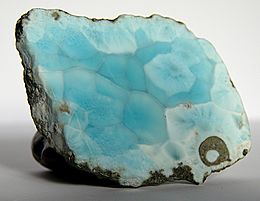Larimar facts for kids
Quick facts for kids Larimar (Blue Pectolite) |
|
|---|---|

Larimar specimen from Dominican Republic
|
|
| General | |
| Category | Inosilicate mineral |
| Formula (repeating unit) |
NaCa2Si3O8(OH) |
| Crystal symmetry | P1 |
| Unit cell | a = 7.99 Å, b = 7.03 Å, c = 7.03 Å; α = 90.51°, β = 95.21°, γ = 102.53°; Z = 2 |
| Identification | |
| Color | Shades of blue, blue-green |
| Crystal habit | Tabular to acicular, radiating fibrous, spheroidal, or columnar; massive |
| Crystal system | Triclinic |
| Twinning | Twin axis [010] with composition plane [100], common |
| Cleavage | Perfect on {100} and {001} |
| Fracture | Uneven |
| Tenacity | Brittle; tough when compact |
| Mohs scale hardness | 4.5 - 5 |
| Luster | Silky, subvitreous |
| Diaphaneity | Translucent to opaque |
| Specific gravity | 2.84 - 2.90 |
| Optical properties | Biaxial (+) |
| Refractive index | nα = 1.594 - 1.610 nβ = 1.603 - 1.614 nγ = 1.631 - 1.642 |
| Birefringence | δ = 0.037 |
| 2V angle | Measured: 50° to 63°, Calculated: 42° to 60° |
| Dispersion | r > v weak to very strong |
Larimar is a special blue gemstone. It's a rare type of mineral called pectolite. You can only find Larimar in one place: the Dominican Republic. It comes from an area near the city of Barahona.
Larimar can be many shades of blue. It can also be bluish-white, light green, or even deep blue and purple. This stone comes in many beautiful color mixes.
Contents
Discovering Larimar
The first mention of this blue rock was in 1916. Father Miguel Domingo Fuertes Loren found a blue stone. He asked for permission to mine it in Barahona. However, his request was turned down. At that time, people didn't know about pectolite in the Dominican Republic.
The stone was rediscovered much later in 1974. Miguel Méndez and a volunteer named Norman Rilling found it. They found the stones on a beach. This beach was at the foot of the Bahoruco Mountain Range.
Naming the Blue Stone
Local people thought the blue stones came from the sea. They called them "Blue Stone." Miguel Méndez gave the stone its unique name. He combined his daughter's name, Larissa, with the Spanish word for sea, mar. This created the name Larimar. It suggests the beautiful colors of the Caribbean Sea.
The first stones found were washed into the sea. They came from the Bahoruco River. Later, people found where the stones came from. They found them in the mountains. This led to the creation of the Los Chupaderos mine.
How Larimar Forms
Larimar is a special kind of pectolite. Pectolite is a mineral made of calcium and sodium. You can find pectolite in many places. But Larimar has a unique "volcanic blue" color. This color comes from tiny bits of copper inside the stone.
Larimar forms inside old volcanic rocks. These rocks are called andesites and basalts. They erupted a long time ago. These rocks had small holes or spaces inside them. Over time, different minerals filled these spaces. Blue pectolite, or Larimar, was one of these minerals.
When these volcanic rocks wear away, the Larimar pieces break free. Rivers then carry these pieces down to the sea. The Bahoruco River carried many Larimar stones. The river's movement polished the stones naturally. This made the blue Larimar stand out against the dark river gravel.
The Los Chupaderos Mine
The main place where blue pectolite is found is called Los Chupaderos. It's in an area called Los Checheses. This spot is about 10 km southwest of Barahona. It is a mountainside with many shafts. There are about 2,000 vertical shafts there. The area is surrounded by rainforest.
Larimar Jewelry
Larimar jewelry is very popular in the Dominican Republic. It is also sold in other Caribbean islands. It's known as a local specialty. Most Larimar jewelry is set in silver. But very high-quality Larimar can also be set in gold.
The quality of Larimar depends on its color. The more intense the blue color, the higher its value. Larimar can also have green parts. Sometimes it has red spots or brown streaks. These are due to other minerals or oxidation. The blue color of Larimar can fade over time. This happens if it is exposed to too much light and heat.
See also
 In Spanish: Larimar para niños
In Spanish: Larimar para niños
- List of minerals
- List of minerals named after people


